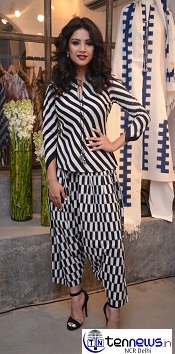Designer Madhu Jain hosted an evening to introduce her Spring-Summer Collection


Designer Madhu Jain hosted an evening to introduce her Spring-Summer Collection
25th Feb, New Delhi: Madhu Jain hosted an evening to introduce her Spring-Summer Collection at “Ogaan” No.H2 Hauz Khas Village. Smt. Maneka Gandhi, Union Cabinet Minister for Women & Child Development, inaugurated the collection. Some of the prominent guests spotted at the event were Designer Poonam Bhagat, Tikka Shatrujit Singh, Ambika Shukla, Neelam Pratap Rudy, Shovana Narayan, Alpana Gujral, Ruchi Malhotra Makhni, and many more.
Spring is in the air! It’s time to shake off the woollies and embrace the coolness and elegance of Indian cottons. Craft Revivalist and Textile Conservationist Madhu Jain, designer extraordinaire, whose formidable reputation has been built on promoting indigenous forms of textile weaving and designs, unveils her vibrant new collection. This time she showcases her brand-new Uzbek-inspired Ikats, alongside a retrospective of her signature Andhra Pradesh and Odisha Ikat styles into which she has infused the Buddhist Mandala design inputs from the textile traditions of Thailand.
Madhu’s forte lies in developing textiles in distinctive combinations of two different weaving traditions to create new textiles, high on quality and design. This seamless blending is Madhu’s speciality, making her a forerunner in the indigenous traditional weaves industry. In her 29-year career, Madhu has experimented extensively with textiles and continues to innovate to craft unique blends that are characteristically true to her natural fibres label. This spring, she takes the craft to a new level, by introducing the motifs and weaves of Ikat from Uzbekistan into her design repertoire.
“My fresh collection showcases a confluence of two cultures—Indian and Uzbek—that share so much in common. Seeing the unifying threads in the traditional weaves of two different regions is something that enthuses and challenges me. I then set about seeing how I can amalgamate the beauty in each to produce a totally new weave that nonetheless stays true to the distinctiveness of the individual cultures. In Andhra, for instance, Ikat fabric is produced on pit looms, and semi-circular frames are used in the preparation of warp and weft. The design sensibility leans towards geometricals. In Odisha, on the other hand, Ikat is inspired by temple motifs and also by nature. So, you will notice parrots, flowers, elephants, and deer. And also, Navagunjara, an animal that is considered to be an incarnation of Vishnu, and which you will find incorporated in Odisha’s traditional Pattachitra paintings. I took both sets of elements and combined them to come up with contemporary weaves that remain rooted in the traditional forms,” says Madhu.
Madhu’s Uzbek-inspired collection does just that! In Uzbekistan, cotton or silk Ikat coats were often createdas robes of honour and formal gifts. They were worn only by the nobility or by rich merchants who could afford to buy these exquisite creations. The colour palette was rich and very, very royal—reds, golden-yellows, incandescent purples. For this collection, Madhu has worked with master weavers to create a convergence of two distinct styles with a colour palette that is largely influenced by Indigo. Atisha Pratap Singh is the face of Madhu Jain’s Spring-Summer line.
Highly regarded as a handlooms specialist whose life quest is revitalising and reinvigorating dying crafts, Madhu has impacted the sector by giving it a fresh lease of life. She has worked with various government and NGOs in development, design, and marketing of indigenous textiles and crafts. In recognition of her excellence in revitalising the crafts sector, for the Opening Ceremony of the Commonwealth Games 2010, she was given the rare honour of crafting an installation in the “Fabric of India” segment. Using the skills of 300 weavers, 500 craftsmen and 200 hand embroidery artisans, Madhu designed and executed a giant 115-feet eco-friendly craft installation using bamboo fibre and Kalamkari craft technique. Here too, she innovated in marrying weaves from two states to create a confluence of cultures.
